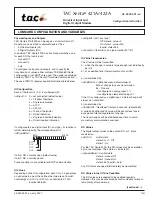
NS4PTOC can be used as main protection for
unsymmetrical fault; phase-phase short circuits, phase-
phase-earth short circuits and single phase earth faults.
NS4PTOC can also be used to provide a system backup for
example, in the case of the primary protection being out of
service due to communication or voltage transformer circuit
failure.
Directional operation can be combined together with
corresponding communication logic in permissive or
blocking teleprotection scheme. The same logic as for
directional zero sequence current can be used. Current
reversal and weak-end infeed functionality are available.
Sensitive directional residual overcurrent and power
protection SDEPSDE
SEMOD171438-5 v6
In isolated networks or in networks with high impedance
earthing, the earth fault current is significantly smaller than
the short circuit currents. In addition to this, the magnitude
of the fault current is almost independent on the fault
location in the network. The protection can be selected to
use either the residual current or residual power component
3U0·3I0·cos
j
, for operating quantity with maintained short
circuit capacity. There is also available one nondirectional
3I0 step and one 3U0 overvoltage tripping step.
No specific sensitive current input is needed. Sensitive
directional residual overcurrent and power protection
(SDEPSDE) can be set as low 0.25% of IBase.
Thermal overload protection, one time constant
LCPTTR/LFPTTR
M12020-4 v14
The increasing utilization of the power system closer to the
thermal limits has generated a need of a thermal overload
protection for power lines.
A thermal overload will often not be detected by other
protection functions and the introduction of the thermal
overload protection can allow the protected circuit to
operate closer to the thermal limits.
The three-phase current measuring protection has an I
2
t
characteristic with settable time constant and a thermal
memory. The temperature is displayed in either Celsius or
Fahrenheit, depending on whether the function used is
Thermal overload protection (LCPTTR) (Celsius) or
(LFPTTR) (Fahrenheit).
An alarm level gives early warning to allow operators to take
action well before the line is tripped.
Estimated time to trip before operation, and estimated time
to reclose after operation are presented.
Breaker failure protection CCRBRF
M11550-6 v19
Breaker failure protection (CCRBRF) ensures a fast backup
tripping of the surrounding breakers in case the own
breaker fails to open. CCRBRF measurement criterion can
be current based, CB position based or an adaptive
combination of these two conditions.
A current based check with extremely short reset time is
used as check criterion to achieve high security against
inadvertent operation.
CB position check criteria can be used where the fault
current through the breaker is small.
CCRBRF provides three different options to select how
t1
and
t2
timers are run:
1. By external start signals which is internally latched
2. Follow external start signal only
3. Follow external start signal and the selected
FunctionMode
CCRBRF can be single- or three- phase initiated to allow its
use with single phase tripping applications. For the three-
phase application of the CCRBRF the current criteria can be
set to operate only if
“2 elements operates out of three
phases and neutral”
for example; two phases or one phase
plus the residual current start. This gives a higher security
to the backup trip command.
The CCRBRF function can be programmed to give a single-
or three- phase retrip to its own breaker to avoid
unnecessary tripping of surrounding breakers at an
incorrect initiation due to mistakes during testing.
Stub protection STBPTOC
M12902-3 v11
When a power line is taken out of service for maintenance
and the line disconnector is opened in multi-breaker
arrangements the voltage transformers will mostly be
outside on the disconnected part. The primary line distance
protection will thus not be able to operate and must be
blocked.
The stub protection (STBPTOC) covers the zone between
the current transformers and the open disconnector. The
three-phase instantaneous overcurrent function is released
from a normally closed, NC (b) auxiliary contact on the line
disconnector.
Overcurrent protection with binary release BRPTOC
GUID-17DA02BB-B0C0-4AE9-8441-DDA4082A776B v4
Overcurrent protection with binary release (BRPTOC) is a
simple, non-directional three-phase overcurrent protection
function with definite time delay. A single step is available
within the function. The current pickup level and definite
time delay can be set independently. It is possible to
release the function operation via a binary signal. If the
binary signal is not connected, the function will
automatically operate in a continuous mode of operation.
Several function instances are available.
From the measured three-phase currents, various types of
measurement modes such as DFT, Peak, and Peak-to-peak
can be selected for the BRPTOC operation.
Line differential protection RED670
1MRK 505 379-BEN R
Version 2.2
Hitachi Energy
43
© 2017 - 2022 Hitachi Energy. All rights reserved
















































